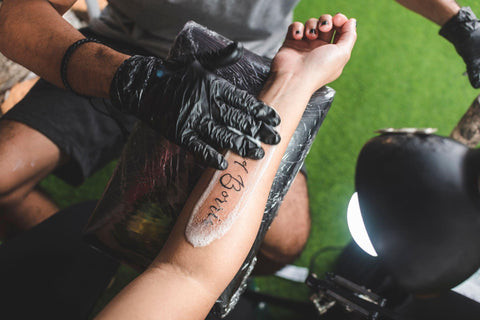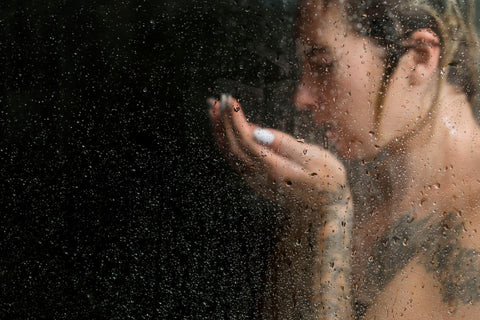What To Wash Tattoos With is a crucial question for anyone getting inked, and tattooat.com is here to provide the ultimate guide for tattoo aftercare. Proper cleansing prevents infection, promotes healing, and keeps your body art looking vibrant for years to come. By following the right washing techniques and using recommended products, you ensure that your new tattoo heals beautifully, preserving the artistry and your skin’s health.
1. Why is Choosing the Right Tattoo Wash Important?
Choosing the right tattoo wash is paramount to avoid complications. Using the wrong products or techniques can lead to infection, scarring, and faded ink. Proper aftercare, especially in the initial weeks, ensures the tattoo heals correctly, maintaining the integrity and vibrancy of the artwork.
1.1. Risks of Improper Washing
Improper washing poses several risks to your new tattoo. These include:
- Infection: Bacteria can enter the broken skin, leading to infections that require medical treatment.
- Scarring: Harsh products or rough handling can cause scarring, distorting the tattoo’s design.
- Faded Ink: Aggressive washing can strip the ink, resulting in a dull and unattractive tattoo.
- Prolonged Healing: Incorrect washing can delay the healing process, increasing the risk of complications.
1.2. Benefits of Proper Washing
Proper washing offers numerous benefits, ensuring your tattoo heals flawlessly. These include:
- Prevention of Infection: Antibacterial washes keep the area clean, preventing bacterial growth.
- Faster Healing: Gentle washing promotes cell regeneration and reduces inflammation.
- Vibrant Colors: Proper care helps the ink settle properly, maintaining the tattoo’s vibrancy.
- Reduced Scarring: Gentle techniques minimize the risk of scarring, preserving the tattoo’s design.
2. What Type of Wash Should You Use on a New Tattoo?
The type of wash you use on a new tattoo significantly impacts its healing process. Opt for antibacterial, fragrance-free washes to minimize irritation and prevent infection. Products with harsh chemicals, fragrances, or alcohol can hinder healing and damage the ink.
2.1. Antibacterial Soaps
Antibacterial soaps are essential for washing a new tattoo. These soaps kill bacteria and prevent infection, promoting a clean healing environment.
- Benefits: Effective at preventing infection, gentle on sensitive skin.
- Ingredients to Look For: Look for ingredients like benzalkonium chloride or triclosan (in areas where it’s still approved).
- Recommended Brands: Consider brands like Dr. Bronner’s Baby Unscented Castile Soap or Dial Antibacterial Soap.
2.2. Fragrance-Free Soaps
Fragrance-free soaps are gentle and minimize the risk of allergic reactions or irritation. Fragrances and dyes can cause adverse reactions, so it’s best to avoid them during the initial healing phase.
- Benefits: Reduces the risk of allergic reactions, prevents skin irritation.
- Ingredients to Avoid: Artificial fragrances, dyes, sulfates.
- Recommended Brands: Look for fragrance-free options from Cetaphil or Dove.
2.3. Hypoallergenic Soaps
Hypoallergenic soaps are formulated to minimize allergic reactions. These soaps are tested to ensure they are gentle on sensitive skin, making them ideal for new tattoos.
- Benefits: Gentle on sensitive skin, reduces the risk of allergic reactions.
- Ingredients to Look For: Minimal ingredients, no common allergens.
- Recommended Brands: Consider hypoallergenic soaps from Aveeno or Neutrogena.
3. How Often Should You Wash a New Tattoo?
Washing your new tattoo too often can dry out the skin, while not washing it enough can lead to infection. A balanced approach is key to ensuring optimal healing.
3.1. Washing Frequency
Wash your new tattoo two to three times a day during the first week. This frequency helps remove bacteria and excess ink without over-drying the skin. After the first week, reduce washing to once or twice a day.
- Morning Wash: Remove any bacteria that accumulated overnight.
- Mid-Day Wash: Cleanse the area after exposure to environmental elements.
- Evening Wash: Prepare the skin for overnight healing.
3.2. Signs of Over-Washing
Over-washing can lead to several signs indicating that you need to reduce frequency. These include:
- Excessive Dryness: The skin feels tight and flaky.
- Irritation: Redness and itching persist.
- Inflammation: The tattoo area becomes swollen and tender.
3.3. Signs of Under-Washing
Under-washing can also cause issues, signaling the need for more frequent cleaning. These signs include:
- Bacterial Buildup: Visible dirt or grime around the tattoo.
- Increased Scabbing: Thick, excessive scabs forming.
- Potential Infection: Redness, swelling, and pus.
4. Step-by-Step Guide to Washing Your New Tattoo
Washing your new tattoo requires a gentle touch and careful technique. Here’s a step-by-step guide to ensure you clean your tattoo effectively without causing damage.
4.1. Gather Supplies
Before you begin, gather all the necessary supplies. This includes:
- Antibacterial, fragrance-free soap
- Lukewarm water
- Clean paper towels
- Clean, soft cloth (optional)
4.2. Wash Your Hands
Begin by thoroughly washing your hands with antibacterial soap. This prevents the transfer of bacteria from your hands to the tattoo.
- Proper Hand Washing: Wash for at least 20 seconds, ensuring you clean between fingers and under nails.
- Rinse Thoroughly: Rinse your hands well to remove all traces of soap.
4.3. Wet the Tattoo
Use lukewarm water to gently wet the tattoo. Avoid using hot water, which can cause irritation and increase bleeding.
- Gentle Water Flow: Let the water run over the tattoo without direct pressure.
- Avoid Soaking: Do not soak the tattoo; keep the exposure to water brief.
4.4. Apply Soap
Apply a small amount of antibacterial, fragrance-free soap to your fingertips. Gently rub the soap over the tattoo in a circular motion.
- Circular Motion: Use a gentle, circular motion to lift away ink and debris.
- Avoid Abrasive Scrubbing: Do not scrub or use a washcloth, as this can irritate the skin.
4.5. Rinse Thoroughly
Rinse the tattoo thoroughly with lukewarm water to remove all traces of soap. Ensure no soap residue remains, as it can cause irritation.
- Check for Residue: Carefully inspect the tattoo to ensure all soap is removed.
- Gentle Rinse: Use your fingertips to help rinse away any remaining soap.
4.6. Pat Dry
Use a clean paper towel to gently pat the tattoo dry. Avoid rubbing, which can irritate the skin and damage the healing tattoo.
- Use Paper Towels: Paper towels are more hygienic than cloth towels, reducing the risk of bacterial contamination.
- Pat Gently: Pat the tattoo dry, applying minimal pressure.
4.7. Apply Aftercare Ointment
After drying the tattoo, apply a thin layer of aftercare ointment. This helps keep the skin moisturized and promotes healing.
- Thin Layer: Apply a very thin layer of ointment; too much can trap moisture and bacteria.
- Recommended Ointments: Aquaphor, Tattoo Goo, or other artist-recommended products.
 Tattoo artist applies aftercare ointment
Tattoo artist applies aftercare ointment
Alt text: Tattoo artist gently cleaning a fresh name tattoo and preparing to apply aftercare ointment on a client’s forearm.
5. What to Avoid When Washing a New Tattoo
Certain practices can hinder the healing of your new tattoo. Avoiding these common mistakes ensures a smooth and successful healing process.
5.1. Harsh Soaps
Avoid using harsh soaps with fragrances, dyes, or alcohol. These ingredients can irritate the skin and delay healing.
- Ingredients to Avoid: Sulfates, parabens, artificial fragrances, alcohol.
- Why Avoid: These chemicals can strip the skin of its natural oils, leading to dryness and irritation.
5.2. Hot Water
Do not use hot water to wash your tattoo. Hot water can increase blood flow, causing bleeding and potentially damaging the ink.
- Use Lukewarm Water: Lukewarm water is gentle and effective for cleaning without causing harm.
- Why Avoid Hot Water: Hot water can also dry out the skin, hindering the healing process.
5.3. Washcloths and Loofahs
Avoid using washcloths or loofahs to wash your tattoo. These items can harbor bacteria and are too abrasive for a healing tattoo.
- Use Your Fingers: Use your clean fingertips to gently wash the tattoo.
- Why Avoid Washcloths: Washcloths can cause micro-tears in the skin, increasing the risk of infection.
5.4. Rubbing Alcohol and Peroxide
Do not use rubbing alcohol or hydrogen peroxide on your tattoo. These substances are too harsh and can damage the skin and ink.
- Use Gentle Soap: Stick to antibacterial, fragrance-free soap for cleaning.
- Why Avoid Alcohol and Peroxide: These chemicals can dry out the skin and fade the ink.
5.5. Over-Washing
Avoid washing your tattoo too frequently. Over-washing can dry out the skin and disrupt the natural healing process.
- Wash 2-3 Times a Day: This is generally sufficient for the first week.
- Adjust as Needed: Reduce frequency if you notice signs of dryness or irritation.
6. Caring for Your Tattoo Beyond Washing
Washing is just one aspect of tattoo aftercare. Proper moisturizing, sun protection, and general skin care are also essential for maintaining the vibrancy and health of your tattoo.
6.1. Moisturizing
Moisturizing helps keep the skin hydrated and promotes healing. Apply a thin layer of aftercare ointment or lotion after washing and drying the tattoo.
- When to Moisturize: After each washing and whenever the skin feels dry.
- Recommended Products: Aquaphor, Tattoo Goo, fragrance-free lotions.
6.2. Sun Protection
Protect your tattoo from the sun by applying a high-SPF sunscreen. Sun exposure can fade the ink and damage the skin.
- Use Sunscreen: Apply a broad-spectrum, high-SPF sunscreen (30 or higher) to the tattoo.
- When to Apply: Apply sunscreen whenever the tattoo is exposed to sunlight.
6.3. Avoiding Irritants
Avoid wearing tight clothing or using products that can irritate the tattoo. This includes:
- Tight Clothing: Can rub against the tattoo, causing irritation.
- Scented Lotions: Can cause allergic reactions or irritation.
- Harsh Chemicals: Avoid contact with cleaning products and other harsh chemicals.
6.4. Staying Hydrated
Drinking plenty of water helps keep your skin hydrated, promoting overall health and faster healing.
- Drink Water: Aim for at least eight glasses of water per day.
- Hydrated Skin: Hydrated skin heals faster and looks healthier.
 Woman drinking water
Woman drinking water
Alt text: Woman in the shower, emphasizing the importance of staying hydrated for skin health and tattoo healing.
7. Addressing Common Concerns and Questions
Many people have questions and concerns about washing their new tattoos. Here are some common issues and their solutions.
7.1. What If My Tattoo Gets Infected?
If you suspect your tattoo is infected, seek medical attention immediately. Signs of infection include:
- Redness: Excessive redness around the tattoo.
- Swelling: Increased swelling and tenderness.
- Pus: Discharge of pus from the tattoo.
- Fever: Feeling feverish or experiencing chills.
7.2. How Long Does It Take for a Tattoo to Heal?
The healing time for a tattoo varies depending on its size and location, as well as individual factors. Generally, it takes about 2-4 weeks for the outer layers of skin to heal and 3-6 months for the deeper layers.
- Initial Healing: The first few weeks are crucial for preventing infection and promoting initial healing.
- Long-Term Healing: The deeper layers of skin continue to heal over several months.
7.3. Can I Use Vaseline on My Tattoo?
While Vaseline was once a popular choice for tattoo aftercare, it is no longer recommended. Vaseline is a petroleum-based product that can trap moisture and bacteria, potentially leading to infection.
- Use Recommended Ointments: Stick to aftercare ointments like Aquaphor or Tattoo Goo.
- Why Avoid Vaseline: It can suffocate the skin and hinder the healing process.
7.4. What About Washing My Tattoo at the Gym?
If you work out, wash your tattoo immediately after your workout. Sweat can harbor bacteria and irritate the tattoo.
- Wash Immediately: Clean the tattoo as soon as possible after exercising.
- Use Antibacterial Soap: Ensure you use antibacterial soap to remove sweat and bacteria.
7.5. Can I Swim With a New Tattoo?
Avoid swimming with a new tattoo until it is fully healed. Pools, lakes, and oceans can contain bacteria that can cause infection.
- Avoid Soaking: Do not soak the tattoo in water until it is fully healed.
- Protect the Tattoo: If you must swim, use a waterproof bandage designed for tattoos.
8. Long-Term Tattoo Care: Maintaining Vibrancy
Once your tattoo is fully healed, continue to care for it to maintain its vibrancy and prevent fading.
8.1. Regular Moisturizing
Keep your tattoo moisturized to prevent the ink from fading and the skin from drying out.
- Use Daily: Apply a fragrance-free lotion daily.
- Hydrated Skin: Hydrated skin keeps the tattoo looking its best.
8.2. Sun Protection
Protect your tattoo from the sun to prevent fading. UV rays can break down the ink and cause the tattoo to look dull.
- Use Sunscreen: Apply sunscreen with a high SPF whenever the tattoo is exposed to the sun.
- Protective Clothing: Wear clothing to shield the tattoo from direct sunlight.
8.3. Healthy Lifestyle
A healthy lifestyle contributes to healthy skin and a vibrant tattoo.
- Balanced Diet: Eat a balanced diet rich in vitamins and minerals.
- Stay Hydrated: Drink plenty of water to keep your skin hydrated.
- Avoid Smoking: Smoking can damage the skin and cause the tattoo to fade.
8.4. Exfoliating
Gently exfoliating the skin around your tattoo can help remove dead skin cells and keep the ink looking fresh.
- Use Gentle Exfoliants: Avoid harsh scrubs that can damage the tattoo.
- Exfoliate Regularly: Exfoliate once or twice a week to keep the skin smooth.
9. Expert Opinions on Tattoo Washing
Insights from tattoo artists and dermatologists can provide valuable guidance on tattoo aftercare.
9.1. Recommendations from Tattoo Artists
Tattoo artists often have specific recommendations for washing and caring for new tattoos.
- Follow Artist’s Instructions: Always follow the aftercare instructions provided by your tattoo artist.
- Product Recommendations: Ask your artist for recommendations on soaps and ointments.
9.2. Dermatologist Insights
Dermatologists can offer advice on maintaining skin health and preventing complications.
- Consult a Dermatologist: If you have sensitive skin or a history of skin issues, consult a dermatologist for personalized advice.
- Professional Care: Dermatologists can provide treatments for any complications that may arise.
10. Discovering Designs, Artists, and Knowledge at Tattooat.com
Ready to dive deeper into the world of tattoos? At tattooat.com, you can explore a vast library of designs to spark your imagination, discover talented artists to bring your vision to life, and access a wealth of knowledge to ensure your tattoo journey is safe, informed, and inspiring. Whether you’re seeking your first piece or adding to your collection, tattooat.com is your ultimate resource for all things tattoo in the USA.
10.1. Vast Design Selection
Find the perfect tattoo design that resonates with your style.
10.2. Expert Artist Directory
Connect with skilled artists who match your aesthetic preferences.
10.3. In-Depth Tattoo Knowledge
Access detailed guides for safe and stunning tattoo experiences.
Caring for your new tattoo is crucial for its long-term appearance and your skin’s health. By following these guidelines on what to wash tattoos with and maintaining a consistent aftercare routine, you can ensure that your ink remains vibrant and your skin stays healthy. Remember, tattooat.com is your ultimate resource for all things tattoo, offering inspiration, information, and connections to talented artists across the USA.
Address: 1825 SW Broadway, Portland, OR 97201, United States.
Phone: +1 (503) 725-3000.
Website: tattooat.com.
Frequently Asked Questions (FAQ)
1. What happens if I don’t wash my new tattoo?
If you don’t wash your new tattoo, bacteria can accumulate, leading to infection and delayed healing. Washing removes excess ink, plasma, and potential contaminants, promoting a clean environment for proper healing.
2. Can I use regular soap on my new tattoo?
No, you should not use regular soap on a new tattoo. Regular soaps often contain fragrances, dyes, and harsh chemicals that can irritate the skin and hinder healing. Always use antibacterial, fragrance-free soap.
3. How much soap should I use when washing my tattoo?
Use a small amount of soap – just enough to create a gentle lather. Applying too much soap can dry out the skin and cause irritation. A dime-sized amount is usually sufficient.
4. Is it normal for my tattoo to peel?
Yes, it is normal for a tattoo to peel during the healing process. Peeling is a sign that the skin is regenerating and shedding dead cells. Do not pick at the peeling skin; let it fall off naturally.
5. Can I use lotion instead of aftercare ointment?
While aftercare ointments are typically recommended for the initial healing phase, you can switch to a fragrance-free lotion once the tattoo has started to heal. Ensure the lotion is gentle and does not contain any harsh chemicals or fragrances.
6. How long should I keep washing my tattoo?
Continue washing your tattoo twice daily until it is fully healed, which typically takes 2-4 weeks for the outer layers of skin and 3-6 months for the deeper layers. Even after it’s healed, maintain good skin hygiene and keep the tattoo moisturized.
7. What should I do if my tattoo is itchy?
Itching is a common symptom during the healing process. Do not scratch the tattoo, as this can damage the skin and increase the risk of infection. Instead, gently pat the area or apply a thin layer of moisturizer.
8. Can I exercise after getting a new tattoo?
Avoid strenuous exercise for the first few days after getting a new tattoo. Sweat can irritate the tattoo, and tight clothing can rub against it. If you do exercise, wash the tattoo immediately afterward with antibacterial soap.
9. How do I know if my tattoo is healing properly?
Signs of a properly healing tattoo include minimal redness, no signs of infection (such as pus or excessive swelling), and gradual peeling. The tattoo should look and feel better each day.
10. Can I take a bath with a new tattoo?
No, avoid taking baths or soaking your new tattoo in water until it is fully healed. Soaking can increase the risk of infection and damage the ink. Stick to quick showers and avoid prolonged water exposure.
